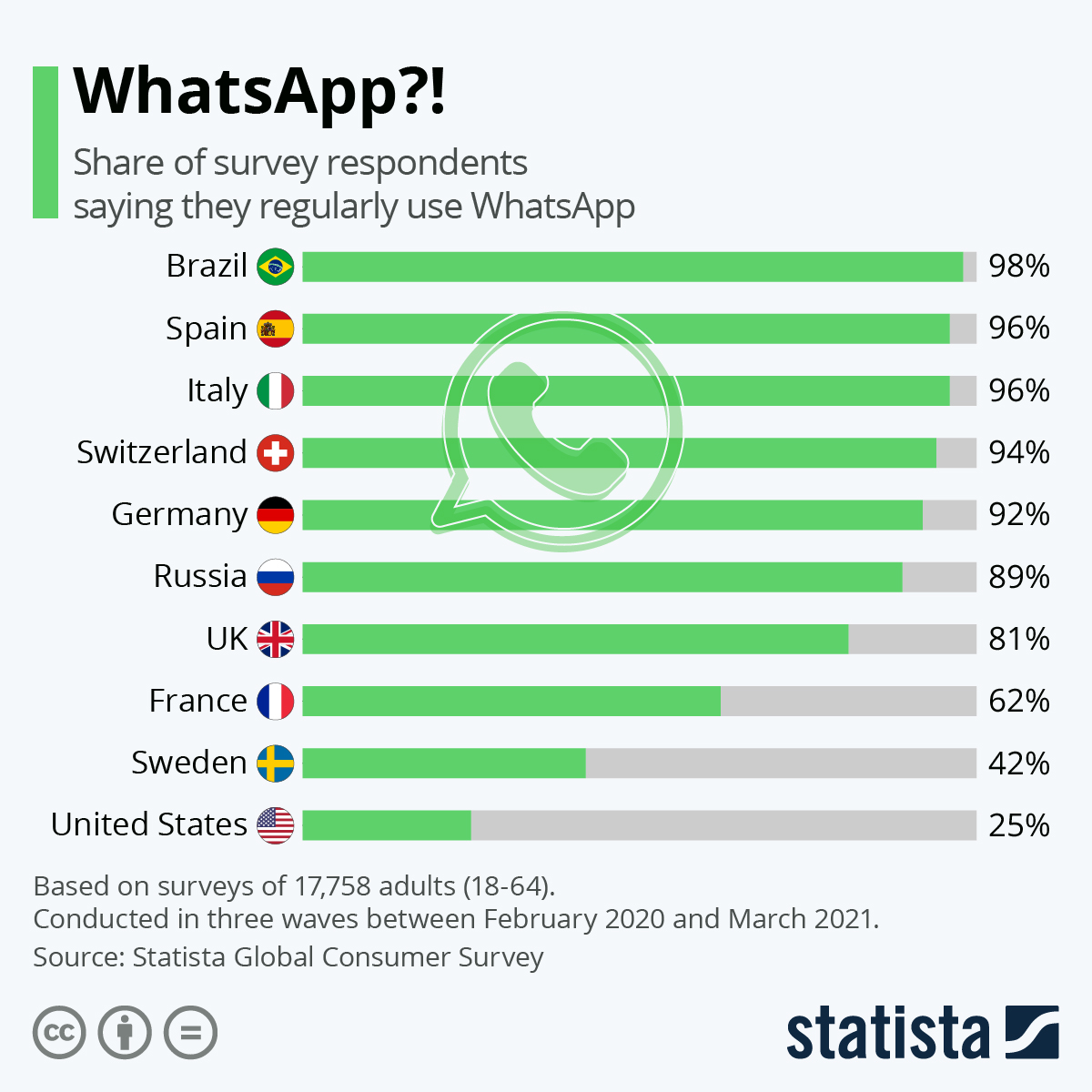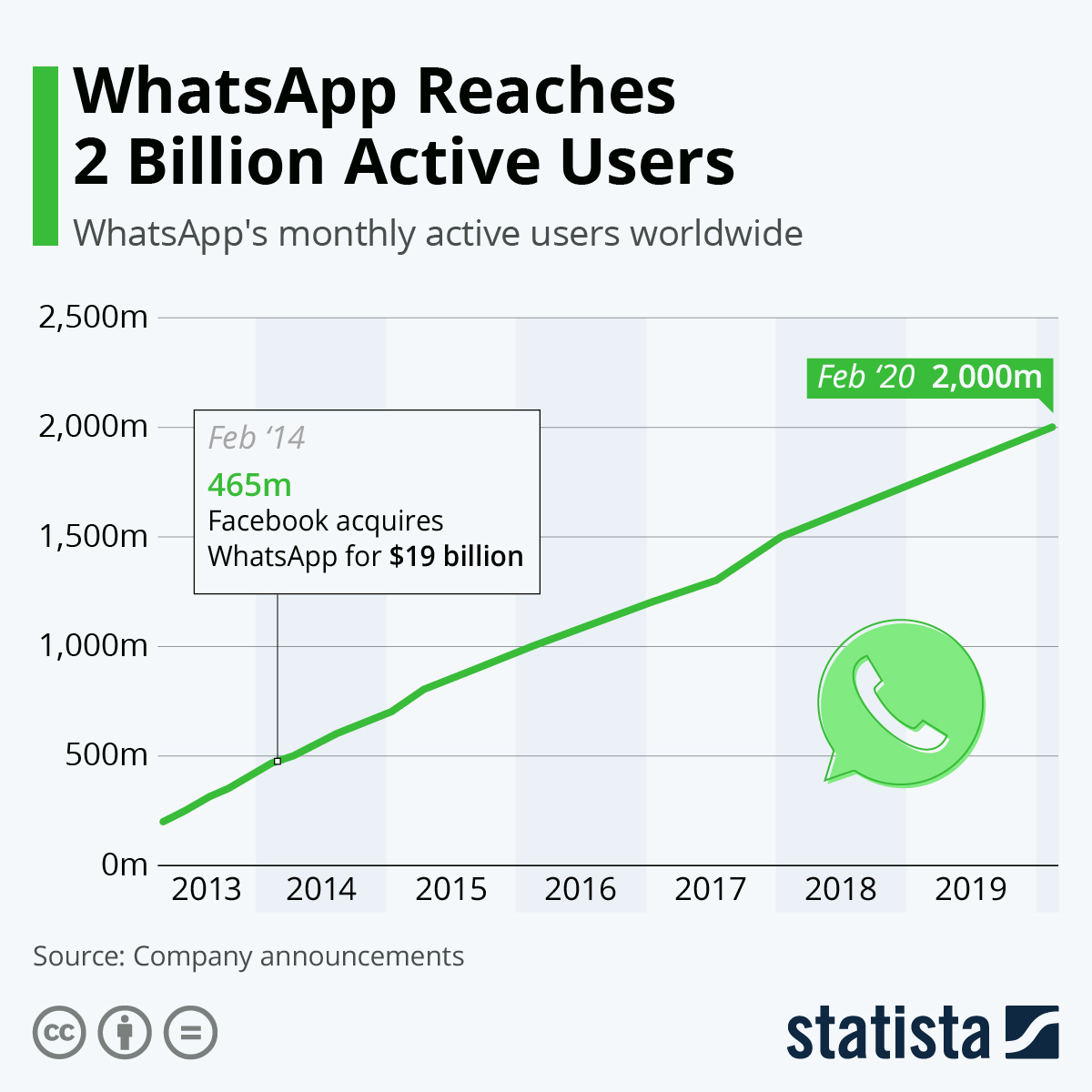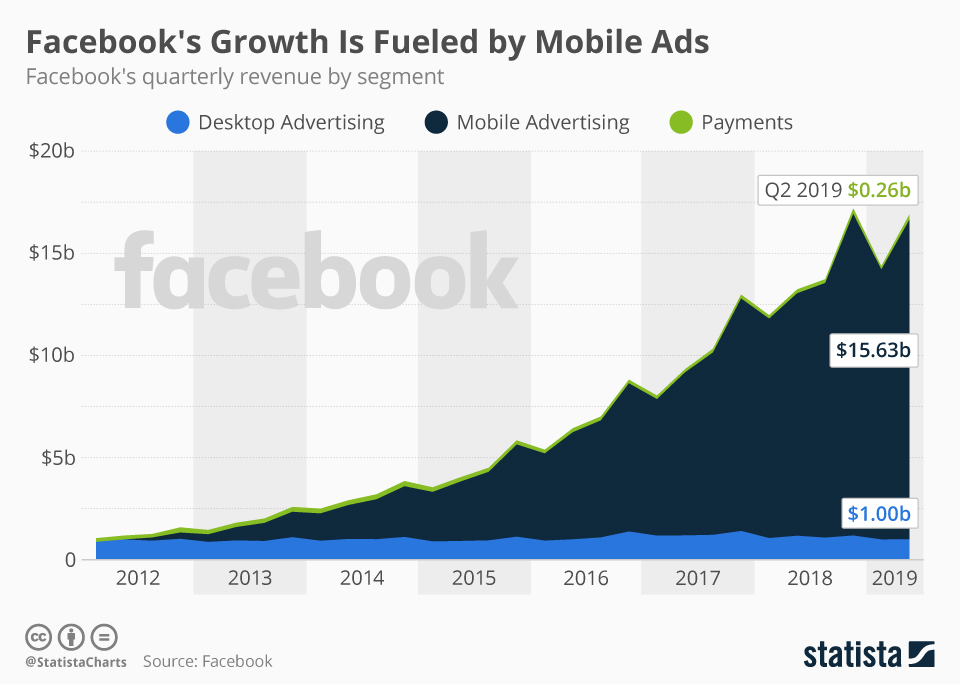Whassup People?
The world has Anheuser-Busch to thank for the name of one of the most popular apps today. Albeit indirectly Budweiser’s campaign ‘‘Whassup?!’ gave rise to a slang phrase that has become a cliché of sorts.
I am pretty sure you have cracked it but if not a few more hints beckon.
What is the first thing you do after waking up in the morning? Most probably, check your phone? A study by IDC Research found that 80% of smartphone users check their phones in the first 15 minutes after waking up.
 You will find more infographics at Statista
You will find more infographics at Statista
Which app do you check first? Are those good morning messages on the family groups a familiar sight? Now you know for sure, don’t you?
WhatsApp it is.
With 2 billion monthly active users, WhatsApp is the most popular mobile messenger app in the world.
Be it for sending memes or video-calling your family and friends to catch up, WhatsApp is the one go-to option. The best part is that all the features are freely available 24X7.
So, have you ever wondered whether WhatsApp makes any money, and if it does, how? If we ask in a more sophisticated way, what is WhatsApp’s business model?
The Dawn of WhatsApp
Rejection is merely a redirection; a course correction to your destiny.
Bryant McGill
Hey, hold on, I am not getting all philosophical here. But this rejection was a major redirection in the lives of billions of people across the globe.
WhatsApp was founded by Brian Acton and Jan Koum in 2009. Before this, both of them worked at Yahoo from 1998 to 2007. Anyway, let us go back to the tale of rejection which is now a part of folklore. Brian Acton was rejected by both Facebook and Twitter in 2009 and in fact, he tweeted about it.
Well, one more tech giant i.e., Apple, played a role albeit indirectly in the germination of WhatsApp. Jan Koum was struck with the idea of WhatsApp as a result of missing calls while at the gym. He realized the scope of the app business on the App Store, launched a few months back by Apple. The initial proposition was to create an app that reflected the status of the users alongside their names.
After brainstorming with Brian, both worked on it to create the iOS version and set up WhatsApp Inc. in California.
Minor Hiccups and a Meteoric Rise
Not everything was hunky-dory in the initial stages. The app crashed frequently due to a variety of bugs. It was Apple once again that paved the way for WhatsApp by launching the feature of push notifications. Whenever a user changed their status, all their contacts would receive a notification. WhatsApp “Photo Status” was a strategic move. How?
This feature was lapped up by the audience. Soon, Koum released an upgraded version of WhatsApp with a messaging interface which revolutionized the landscape of instant messaging forever.
The only other free application for texting at that point was Blackberry’s BBM, but it was exclusive to Blackberry users. WhatsApp filled the demand gap and was promptly rewarded with over 2,50,000 downloads in a matter of days.
WhatsApp’s first seed funding of $250,000, was courtesy of Acton’s five former colleagues at Yahoo. This money helped them in hiring developers to create the app version for Android and BlackBerry users.
At this stage, Whatsapp could have easily monetized but both Kaum and Acton were ad aversive and wanted to offer a smooth experience to the app users without intrusions. It made them a user favorite, proven by the fact that WhatsApp was among the top 20 apps in the U.S. App Store by 2011.
The rising popularity of WhatsApp was purely based on word-of-mouth as it catered to the convenience of users. It took a giant leap between 2011 and 2013, as Sequoia Capital pumped in a total of $60 million in two rounds of funding.
By February 2013, WhatsApp had around 50 staff members and approximately 200 million active users, making it one of the most popular apps.
 You will find more infographics at Statista
You will find more infographics at Statista
With a stringent anti-ad policy courtesy of the founders, WhatsApp dabbled with a freemium business model to garner revenue. Then the question comes again. How does Whatsapp make money?
In some countries, the app cost $1 to download; in others, the first year was free, followed by each ensuing year costing $1.
WhatsApp had 700 million active users at the height of this subscription model though raking in only around $20 million annually in revenues. The future seemed to hold high promise for WhatsApp.
Facebook Comes Calling
An email can change one’s life in myriad ways. From the ecstasy of getting hired to the dejection of getting rejected.
It was the spring of 2012 when Koum received an email with the subject line “Get together?”
The sender was a certain Mr. Zuckerberg, asking for a meeting over dinner. The following year or so witnessed a lot of such meetings brewing a potential acquisition.
The WhatsApp founders also had a meeting with the then Head of Android at Google, Sundar Pichai (now the CEO), who introduced them to the then Google CEO and co-founder Larry Page. Eventually, nothing came out of it.
Valentine’s Day often gives rise to contrasting emotions, and it was just a day later on 15th February 2014, that the world saw a symbiosis that became a talking point.
Facebook acquired WhatsApp for a colossal/whopping/gigantic/jaw-dropping (add other adjectives as you please) $19 billion. The final value rose to $22 billion courtesy of the share-based agreements of the deal.
The deal made Acton and Koum overnight billionaires. From being rejected by Facebook for a job to harboring a multi-billion deal with them, life had come more than the full circle for Acton. It seems like a story that is too good to be true, doesn’t it? Well, it is true, but it did not have a fairy-tale ending.
The Fall Out
Although the deal went through smoothly, cracks started to appear pretty soon. There was a clash of ideologies between the management at Facebook and the WhatsApp founders. This rule ensures that not even WhatsApp knows about the content exchanged by its users.
The inclusion of targeted ads within the app was a bone of contention. The tension was palpable, and something had to give. Within a span of 7 months, from September 2017 to April 2018, both Acton and Koum quit Facebook.
The story does not end here, as Facebook went on with its plans for WhatsApp.
How is WhatsApp planning to make money? What is WhatsApp’s business model?
Overtime WhatsApp has tried and tested several ways to make money but none of them has actually proven to be a breakthrough revenue stream. Although the subscription model was called off in January 2016 and WhatsApp became free globally, Facebook was keenly looking at strategies to monetize the app.
For Facebook, a company that makes 99% of its revenue from advertising, WhatsApp presents a chance to diversify its business model by creating sources of other revenue streams as WhatsApp does earn money through typical advertisements. Until now, WhatsApp had been the go-to app to communicate for personal usage. Businesses were the cohort that seemed to be the next sensible target.
 You will find more infographics at Statista
You will find more infographics at Statista
It gave rise to the WhatsApp Business API. Though the app remained free for businesses to download, they were charged a specific fee for late replies to user messages. How WhatsApp Business is helping businesses to survive Covid-19?
Businesses can respond for free to user messages only within 24 hours since the message is received. Any response after that comes with a fee depending on the location. It gave WhatsApp a source of revenue and more leverage from the user side, courtesy of the incentive for businesses to reply faster. Some of their clients include BookMyShow, redBus, Booking.Com, and many more.
WhatsApp has also entered the payment services with its WhatsApp payment services in India, its biggest market based on user count, with over 400 million users. WhatsApp Pay went live in India in November 2020 after first testing the feature in February 2018.
With a huge user base, this feature was expected to set new landmarks in the domain of Unified Payments Interface (UPI), but the reality has been contrasting. Since its launch, WhatsApp Pay has garnered only 0.02% of UPI volumes and 0.01% of the transaction value.
Some reasons that could have contributed to this are:
- WhatsApp Pay has not onboarded merchants at a rapid pace to facilitate peer-to-merchant (P2M) transactions
- Minimal promotional activity to create awareness about the payment feature, and hence people still look at it primarily as an app to communicate
- A pretty late market entry compared to its competitors like PhonePe and Google Pay
- Unlike its competitors, WhatsApp does not offer incentives like cashback.
Despite all this, WhatsApp with its gigantic user base, cannot be written off just yet. Facebook acquiring a 9.99% stake in Jio Platforms at $5.7 billion in April 2020, seems to be hinting at long-term plans.
WhatsApp is a cash register for Facebook’s business model in Future
There have been reports about Facebook planning to introduce ads in WhatsApp through the status feature and posting ads on Facebook itself that redirect users to WhatsApp business accounts for further engagement. Also, with more than 100 billion messages being exchanged per day, the amount of data that WhatsApp generates is a gold mine.
The exact money that WhatsApp makes is unknown, as Facebook does not provide a revenue breakdown of all its products. As per an estimate made by Forbes in 2017, when WhatsApp had around 1.3 billion users, the app could rake in anywhere between $5 to $15 billion with average revenue per user (ARPU) ranging from $4 to $12.
The scope has just increased, with over 2 billion users as of now. With a sky-high earning potential yet to be realized, it would not be surprising to witness WhatsApp’s monetization strategies as critical.
-AMAZONPOLLY-ONLYWORDS-START-
Also, check out our most loved stories below

Why did Michelin, a tire company, decide to rate restaurants?
Is ‘Michelin Star’ by the same Michelin that sells tires, yes, it is! But Why? How a tire company evaluations became most coveted in the culinary industry?

Starbucks prices products on value not cost. Why?
In value-based pricing, products are price based on the perceived value instead of cost. Starbucks has mastered the art of value-based pricing. How?

Nike doesn’t sell shoes. It sells an idea!!
Nike has built one of the most powerful brands in the world through its benefit-based marketing strategy. What is this strategy and how Nike has used it?

Domino’s is not a pizza delivery company. What is it then?
How one step towards digital transformation completely changed the brand perception of Domino’s from a pizza delivery company to a technology company?

BlackRock, the story of the world’s largest shadow bank
BlackRock has $7.9 trillion worth of Asset Under Management which is equal to 91 sovereign wealth funds managed. What made it unknown but a massive banker?

Why does Tesla’s Zero Dollar Budget Marketing Strategy work?
Touted as the most valuable car company in the world, Tesla firmly sticks to its zero-dollar marketing. Then what is Tesla’s marketing strategy?

Apple – A Unique Take on Social Media Strategy
Apple’s social media strategy is extremely unusual. In this piece, we connect Apple’s unique and successful take on social media to its core values.
-AMAZONPOLLY-ONLYWORDS-END-


















